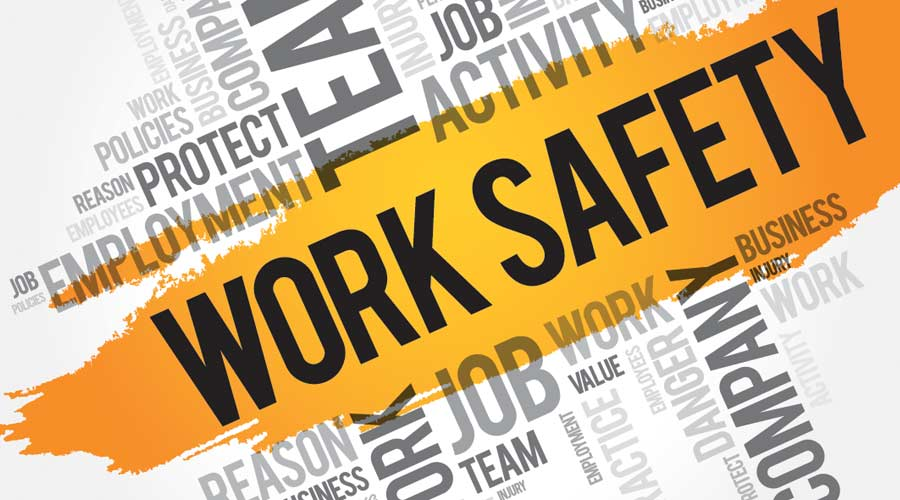
Work Site Safety Audits
A Work Site Safety Audit is an important part of any workplace. It helps to identify potential hazards and risks, and ensures that all safety protocols are being followed. The audit includes a comprehensive review of the environment, as well as any equipment or materials used in the area. It can also include interviews with employees and other stakeholders to assess their understanding of safety policies and procedures.

Safety Audits vs. Safety Inspections: What’s the Difference?
Safety audits and safety inspections serve different purposes. Safety audits are more comprehensive and review the overall safety program of an organization, while safety inspections focus on specific worksites or processes.
Audits evaluate compliance across multiple areas such as employee training, equipment maintenance, hazardous materials management, accident investigation/reporting procedures, emergency response plans, etc., whereas inspections are conducted to ensure that existing regulations and requirements are being met in a particular area (e.g. confined space entry, machine guarding).
Safety audits provide organizations with valuable feedback on their current safety practices and allow them to identify any potential risks before they become significant issues. Inspections can help find violations quickly and lead to corrective actions when needed. Both types of assessments are important components of an effective safety management system.

3 Types of Safety Audits
There are three primary types of safety audits: administrative, environmental, and personal protective equipment (PPE). Administrative audits assess compliance with safety policies and procedures; environmental audits evaluate the physical environment for conditions that may pose a risk to personnel; and PPE audits review the effectiveness of an organization’s PPE program in providing adequate protection for workers.
All three types of safety audit provide valuable insight into the overall safety performance of a company, helping to ensure that it is meeting its commitment to providing safe working conditions.

How to conduct a safety audit?
Conducting a safety audit is an important step in improving the safety of any workplace. It allows organizations to assess their current protocols and identify areas for improvement. When conducting a safety audit, it is important to consider all potential hazards and develop safety regulations and safety procedures to eliminate or control hazards.
This can include everything from evaluating how equipment is used and maintained, to reviewing employee training programs and procedures. Additionally, health and safety audit companies should pay attention to the environment around the facility, ensuring that employees are working in safe conditions with reasonable access to emergency exits.
After identification of risk areas, action plans should be developed and implemented in order to make sure that all necessary steps have been taken in order to provide a safe working environment for everyone involved. Finally, employers should regularly review their safety audit report and audit data and make adjustments to ensure that the workplace remains safe for all workers.
By doing this, businesses can prevent major accidents from occurring and create a safer work environment for everyone. Through consistent safety audits, organizations can be sure that they are taking every measure to ensure the wellbeing of their employees.

The Steps of a Successful Safety Audit
A safety audit is an important part of any successful workplace safety program. It helps to identify risks and implement controls that protect workers and facilitate compliance with relevant legislation.
The steps involved in a successful audit include planning the review process, conducting interviews, collecting data, analyzing results, revising policies and procedures as needed, and finally reporting findings to key stakeholders. To ensure optimal results, it’s important to consult experts who have knowledge of applicable regulations and industry best practices.
With audit findings, workplaces can create safer environments for all personnel. Doing so will go a long way towards preventing accidents or injuries from occurring. Ultimately this leads to increased productivity and improved morale among employees.
The benefits of conducting regular audits are clear and there are many resources available to help employers ensure their workplace safety programs meet or exceed standards. With the right approach, any organization can benefit from a successful safety audit process.
By taking the steps necessary to conduct an effective safety audit, companies can have peace of mind that they are putting their employees first while complying with relevant laws and regulations. Additionally, an audit helps organizations identify areas of potential improvement in order to strengthen existing policies and procedures and create a more secure environment for workers.
This is essential to creating a culture of safety within any organization. Conducting regular audits helps ensure safe working conditions and ultimately better outcomes for everyone involved.

Prepare for the Audit
It is important to thoroughly prepare for an audit, as it will help ensure that the process runs smoothly. Start by gathering all relevant documents and financial statements in one place. It is also beneficial to have a checklist of items that need to be addressed during the audit.
Additionally, make sure you are aware of any applicable laws and regulations related to your industry and business operations.

Access Expert Safety Auditors + EHS Software and Training with KPA
KPA’s Expert Safety Auditors and Environmental Health & Safety (EHS) Software and Training solutions are designed to help businesses keep their employees safe, comply with regulations, and reduce risk.

What are the Benefits of Performing a Safety Audit?
Performing a safety audit is an essential part of any workplace safety program. Regularly performing safety audits helps to identify potential risks, ensure compliance with industry standards and regulations, minimize accidents and injuries, and keep workers safe. Safety audits also help to reduce costs associated with legal fees, insurance premiums, medical expenses, lost time due to injuries or illness, and other related costs.
In addition to this financial benefit, regular safety audits can increase employee morale by demonstrating the commitment of management towards workplace safety. Overall, the benefits of performing a safety audit are clear – improved worker health and reduced potential liability for employers.

How frequently should safety audits be conducted?
When it comes to safety audits, the frequency of their execution can vary depending on a variety of factors. Generally speaking, these audits should be conducted at least once a year. However, this timeframe may need to be adjusted depending on the industry, environment and context of the business in question.

What Are the Best Practices in Conducting Safety Audits?
Safety audits are essential for any work environment, and there are best practices that should be followed when conducting them. First, safety audits should be conducted regularly to ensure all areas of the workplace are up-to-date on safety standards.
It’s also important to involve personnel who can provide a fresh perspective and spot potential hazards. Additionally, auditors should document their observations as they conduct the audit, which allows for an objective assessment of safety practices.
Finally, it’s important to take any corrective actions needed following the audit in order to ensure a safe and healthy work environment. Following these best practices can help create an effective safety audit that ensures all areas of the workplace are up-to-date on standards and that potential hazards are identified and addressed quickly.

What is a Compliance audit?
A Compliance audit is a systematic review of an organization’s policies, procedures, and operations to ensure that they are in alignment with legal and regulatory requirements. It is a comprehensive evaluation of the effectiveness of internal controls across all areas of the business.
The main goal of this audit is to identify potential risks or weaknesses in the processes so that corrective action can be taken accordingly.

Use Competent and Objective Auditors
Competent and objective auditors play an essential role in ensuring the accuracy of financial documents. Auditors are responsible for evaluating the accuracy of financial records, assessing internal controls, analyzing transactions to detect errors, and providing assurance that the financial statements present a fair view of the company’s performance.
They must have expertise in accounting principles and be able to assess potential risks with objectivity. Auditors must also be able to clearly communicate their findings and recommendations in a way that is understandable to management.
An effective auditor will use a range of different techniques, such as reviewing documents, interviewing staff, using electronic data analytics tools and performing testing procedures, to ensure accuracy and completeness of the financial records.

What Are the Key Elements of a Safety Audit?
A safety audit is an essential tool for any organization that wants to ensure the health and safety of its employees. The key elements of a safety audit are identifying potential hazards, assessing the risk associated with these hazards and determining how best to reduce or eliminate them. To do this, workers must be trained in hazard identification, risk assessment methods, and prevention techniques to control risks.
Additionally, policies and procedures must be created and enforced to reduce the chance of harm or injury occurring in the workplace. Finally, safety audits should include regular follow-up reviews to ensure that any changes have been effective in improving safety. By using a comprehensive approach to safety management through a safety audit, organizations can help protect their staff from potential hazards and prevent accidents from occurring.

What is the difference between an auditor and assessor?
The main difference between an auditor and an assessor is the purpose of their respective roles. An auditor is responsible for verifying that financial information or systems are accurate and in compliance with laws, regulations, and standards.
An assessor’s role is to measure or evaluate a system, process, project, or organization against a set of criteria. Additionally, auditors are usually outside third-party professionals, while assessors can be internal staff employed by the organization they are evaluating. Ultimately, an auditor is interested in determining the truth of a situation, while an assessor is focused on understanding how well it meets standards or criteria.
Both roles play a valuable role in ensuring that financial and operational information is accurate and meeting legal requirements.

Does OSHA require safety audits?
Yes, OSHA does require safety audits for employers to ensure that their workplaces are safe and in compliance with the Occupational Safety and Health Act (OSHA). By conducting regular safety audits, employers can identify potential hazards and take measures to reduce them.
This helps protect employees’ physical health by reducing the risk of workplace injuries, as well as their mental health by creating a positive working environment. OSHA safety audits allow employers to identify potential hazards and make sure that their workplace is in compliance with the OSHA standards, thus protecting both employees’ physical and mental well-being. Additionally, regular safety audits can help employers save on costs by reducing liability in case of an accident or injury.

Need Help?
Our team of experts can help you with whatever compliance issues you may be facing. Whether it is understanding the complexities of a given regulation or recognizing where your company needs to improve, we have the necessary skills and experience to provide assistance. We will take the time to understand your unique needs and develop tailored solutions that address those needs. For facilites looking for help navigating the often perplexing regulatory landscape, contact us today!

Need an Audit?
Are you thinking about getting an environmental audit? Let us help!